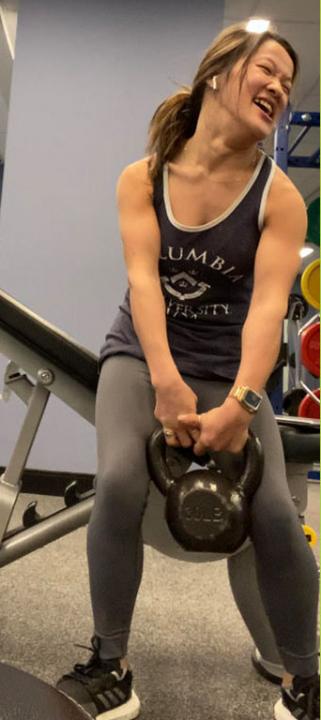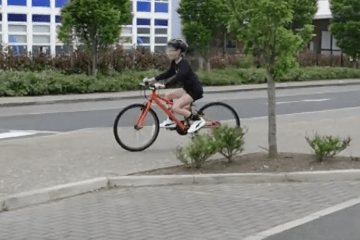Exercising at Home During Quarantine

One of the hardest moments during quarantine for me was when my apartment building announced its gym was closing to prevent the spread of coronavirus. As the outside gyms closed all around the city in the weeks prior, I felt grateful that the one in my building was open. The gym was the lasting lifeline to my sanity, and to have that yanked away from me, I felt lost.
When I was apartment hunting two years ago, the realtor reassured me that although the studio unit was small, it wouldn’t matter that much since I would only come home to sleep, and the building had a bunch of amenities. Undoubtedly, the realtor couldn’t possibly have predicted that a global pandemic would be in our future and would force me to be confined to the 460-square-foot apartment, along with others into similar situations.
To be frank, the thing I feared the most was my physical wellness deteriorating throughout quarantine. Over the past two years, I have transitioned out of using my wheelchair and, instead, walking everywhere. Becoming fully ambulatory has been a goal I’ve had since high school, and I knew it was within my reach. Once I completed graduate school, I had much more time on my hands to exercise more rigorously and to take yoga and barre classes that improved my flexibility and relieved my muscle stiffness.
Although this is not the case for everyone with cerebral palsy, I found that a combination of group fitness classes and routine gym exercises have significantly improved my endurance and posture. While in school, I couldn’t walk more than a mile without tendonitis on my hip flaring up or getting extremely fatigued. Now, a few years later, I was walking an average of five miles a day without pain or exhaustion. I had even locked away my wheelchair in storage.
A month into quarantine, I could already notice a decline in my physical strength. While significantly shifting my daily routine and adjusting to my boyfriend moving in with me, a month had gone by with me doing little to no exercise. By mid-April, even going to the grocery store 0.2 mile away had become taxing. I took this as a wake-up call and decided to start maintaining an at-home exercise routine.
Luckily, spring has finally sprung in NYC for the most part (did anyone see those snow flurries on Mother’s Day weekend?), so going on daily walks/runs is much easier than it was at the start of quarantine. I aim to walk a minimum of 30 minutes outside each day. And if the weather is terrible outside, I go up and down several flights of stairs in my building. Not only do these outdoor activities, while wearing masks and keeping proper social distancing measures, and simple at-home workouts have improved my physical wellness, but also my mental health and work productivity.
As CPF we want to encourage physical and mental wellness within our community. It is in the spirit of togetherness and unity that we want to inspire each other to maintain good health and positivity. May is also National Physical Fitness Month, and what a better way to start the summer than in good health!
Before you begin an exercise routine you should consult with your healthcare provider. Here are some at-home exercises I’ve found helpful for my muscle tightness and overall wellness.
To start, I’ve bought the following exercise equipment. Some fitness experts have mentioned that using your bodyweight for exercises is sufficient, but there are certain muscle areas I wanted to target. Plus, my spasticity can sometimes interfere with how well I can form certain poses.
* One-inch thick yoga/exercise mat (the extra thickness is much better for my joints)
* 5- and 8-inch neoprene dumbbell weights (the material makes it easier for griping)
* Set of multi-level resistance mini bands
* Set of multi-level resistance (long) bands
* Ankle weights
* Yoga block
* Stretching/yoga band
If purchasing exercise equipment is an issue, then there are plenty of household items you can use as substitutes for weights and stretching bands. For example, you can use jars of pasta sauce as weights. If you’re afraid of not having strong enough grips on the jars to prevent from dropping them, then place them in canvas bags and lift them by using the bag handles. You could also use hardcover books or textbooks as weights.
Additionally, I found out you can do a lot of exercises from barre class using a chair or table as a ballet bar. Luckily, tons of exercise videos are readily available on YouTube and IGTV, so I go to the pages of my favorite fitness studios for inspiration for workout routines.
Obviously, everyone, with or without a disability, has a different range of motion and flexibility as well as overall ability. You may or may not find these exercises helpful, but hopefully, at the very least, they may inspire you to create your own exercise program.
Yoga poses as pre- and post-workout stretches: As much as I’ve tried to be, I’m not a yogi. I’m very much of a high-intensity, fast-paced exercise person. However, I find many yoga poses help stretch my muscles, so I start and end each exercise by doing 5-10 minutes of yoga. My favorite poses to do are:
* Cat/cow
* Downward-facing dog
* Supine twist
* Child’s pose
* Extended puppy pose
* Head-to-knee forward bend
* Extended triangle pose
* Pigeon pose
One good thing about yoga is that there are ways to modify each pose and still get the intended stretch, like using a yoga block for the pigeon pose if you have limited flexibility.
In addition to yoga, since I have tight hamstrings like many people with CP, I like to use the stretching band (or use a resistance band or a rope) to give myself a good hamstring stretch.
I tend to focus on a specific part of my body each time I exercise, but do a full-body workout once a week. For example, here is my workout schedule for a typical week:
* Mondays are “arm days,” when I do bicep and tricep curls, as well as pushups and free-weight rows.
* Tuesdays are “leg days.” I use my ankle weights to do leg lifts/kicks and resistance bands to do bridges.
* Wednesdays are “core days” with sit-ups, planks, and squats. To increase the intensity of these exercises, I like to use resistance bands and weights.
* Thursdays are my “rest days” and I just take walks and do stretches. I don’t want to overwork my muscles so I let my body recover from the past three days’ worth of work.
* Fridays are my “fun, full-body days.” I make my boyfriend workout with me and we do Zumba or Peloton Boot Camp classes online.
* Saturdays and Sundays are kind of a free-for-all. I usually run errands and do chores around the apartment, so I move around more than I do on a weekday. I’m not particularly concerned about sticking to a routine on the weekends.
Like most things in life, getting started is the hardest part of maintaining an exercise routine. But once you get into a rhythm, you feel less stressed about working out, and it can even become something you look forward to each day! Let’s #MakeMayMatter and #MoveInMay together while still maintaining proper social distancing.






